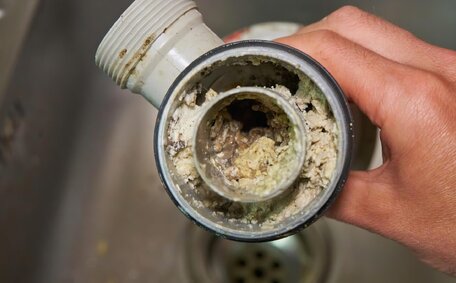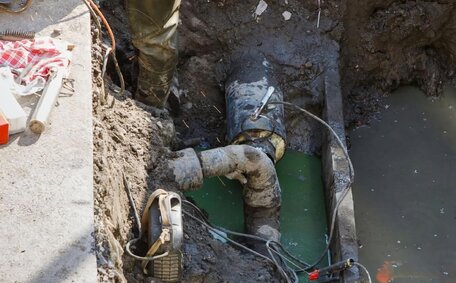Introduction: How Soil and Sediment Impacts Blocked Drains
When rains are particularly heavy, you may notice water pooling around storm drains or your gutters overflowing. Such flooding can cause disruptions beyond the immediate impact of the rainfall volume. Soil erosion and sediment buildup often block drainage pathways, preventing proper water flow.
At North Mead Plumbing, we understand the connection between soil and sediment and common drainage issues like clogs.
This article will examine the relationship between sediment and blocked drains. You’ll also learn some practical solutions to mitigate issues with sediment blockage.
We’ll look at how soil erosion impacts water quality and drainage systems over time. Proper installation and maintenance of drainage infrastructure plays a key role as well. We’ll look at how soil erosion impacts water quality and drainage systems over time. We’ll look at how soil erosion impacts water quality and drainage systems over time.
Sources and Impacts of Sediment on Water Quality
Sediment enters waterways from several sources, especially in urban environments. Stormwater washes loose soil and debris from exposed land into nearby drains.
Construction sites lacking proper erosion control contribute a significant amount of sediment runoff. Construction sites lacking proper erosion control contribute a significant amount of sediment runoff. Over time, this steady supply of sediment flowing into watercourses can have major consequences.
Excess sediment negatively impacts water quality in a few key ways. This harms aquatic plants and organisms.
Sediment particles transport heavy metals, pesticides, fertilisers and other toxic substances into streams, rivers, lakes and oceans. As sediment settles, it makes the water murky and turbid, reducing the amount of sunlight penetration. Sediment particles transport heavy metals, pesticides, fertilisers and other toxic substances into streams, rivers, lakes and oceans.
Proper drainage infrastructure installation and maintaining sediment controls are necessary to mitigate these issues. Strategies include silt fencing around construction areas, stabilising exposed soil, storm drain filters and retention ponds. Proper drainage infrastructure installation and maintaining sediment controls are necessary to mitigate these issues. Our team at North Mead Plumbing can help design effective drainage solutions for your property.
Soil Erosion Causing Drainage Issues
Soil erosion takes place when soil particles are washed away by wind or water. Several factors come into play with erosion including the volume and velocity of water flows, the type of soil, slope gradient and ground cover vegetation.
During heavy rains, fast moving stormwater can rapidly erode soil, washing sediments into nearby drains. Over time, this steady buildup of fine sediment, such as sand, silt, and clay, leads to clogged pipes. Plant roots, debris and other organic matter further exacerbate drain blockages once soil sediment accumulates.
Signs your drains are blocked due to sediment washout include gurgling sounds, very slow drainage after using sinks or toilets, pooling water and strong sewage odours. These issues generally start small but worsen progressively.
Soil erosion and sediment buildup pose major risks for homeowners and businesses alike. Clogged drains lead to backed up plumbing and flooding, which causes substantial water damage.
Sediment also harms the environment by diminishing water quality once it enters, an issue waterways can frequently face.Mitigating erosion is key to preventing sediment related drainage problems. Strategies include stabilising soil with vegetation buffers, using silt fences and drain covers, and ensuring proper drainage capacity.
Installation and Maintenance of Drainage Systems
Installing drainage systems correctly is crucial to avoid issues with sediment down the track. Our licenced plumbers at North Mead Plumbing follow best practises when designing and fitting new drainage for properties. This includes conducting thorough site evaluations to determine drainage capacity needs and mapping out piping layouts suited to the terrain.
We select quality materials designed to withstand heavy soil and debris loads. Drains are laid at sufficient gradients to facilitate gravity-powered water flows. Appropriate drainage venting also helps water drainage while preventing foul sewer gases from entering buildings.
Our standard drains range from 90mm to 150mm in diameter, with larger sizes used for high volume applications.
proper installation, routinely maintaining drains is vital. We recommend inspecting external drains before winter and after heavy rainfall. Clear any accumulated debris like leaves or silt around grates.
Our team can jet clean drain lines to remove minor sediment buildup internally before it escalates. More severely blocked pipes may require manual rodding, high-pressure hydro jetting or full replacement.
Early intervention prevents major headaches later.
If you suspect your drains are starting to clog due to soil deposits, contact North Mead Plumbing. If you suspect your drains are starting to clog due to soil deposits, contact North Mead Plumbing. We can also suggest solutions to help curb sediment entry in the first place.
Using Silt Bags for Sediment Control
Silt bags provide a simple but effective means of controlling sediment runoff from sites with exposed soil. They are often deployed on small residential building projects where space constraints limit the use of traditional sediment traps and ponds.
Silt bags consist of a perforated durable PVC bag with openings large enough to allow water to pass through while capturing larger soil particles. The bags are placed at stormwater outlets, acting as a last line of defence to filter out sediment before it leaves the property.
As stormwater flows into the bag, sediments settle to the bottom while allowing clearer water to exit through the perforations.
Using silt bags can reduce sediment loss by up to 80 percent. They present several advantages over other sediment control methods:
- Compact size suitable for small building lots
- Inexpensive compared to installed sediment traps
- Easy to install by hand without machinery
- Bags are reusable on multiple projects
To install silt bags, start by selecting suitable locations downhill from soil disturbance areas. Place bags flat on the ground and use stakes to secure them. Inspect after wet weather and regularly clean out accumulated sediment.
Connect the top of the bag to PVC pipes leading from drains or gutter outlets so all the water flows through the bag.
Using silt bags prevents excess sediment from leaving properties and entering waterways during construction or landscaping work. They protect drainage infrastructure from accelerated clogging issues. Contact our team at North Mead Plumbing if you need guidance installing or maintaining sediment controls on your next project.
Preventative Measures for Sediment Issues
There are several effective preventative measures homeowners and businesses can take to reduce issues with sediment buildup in drains.
Landscaping techniques help stabilise soil vulnerable to erosion. Options include:
- Planting native trees, shrubs and grasses with dense root systems to bind topsoil
- Installing rock walls or vegetation buffers on steep slopes
- Placing erosion mats and geotextiles over freshly disturbed ground
Careful waste disposal also prevents contamination from litter, chemicals and hazardous fluids. Ensure sinks are strainer-protected and toilets have flushable wipes discarded in bins, not the sewer.
Sediment loss occurs gradually over time. Routinely inspect your drainage and clear surface debris around grates after heavy rainfall. Our team at North Mead Plumbing can jet clean lines to remove minor sediment accumulation before major blockages develop.
We recommend constructing sediment traps if building a house extension or undertaking major landscaping. Properly installed systems capture eroded soils before they reach drains. If undertaking smaller renovations, use silt fencing and bags to filter sediment.
Following these simple sediment control measures reduces risks considerably. Contact North Mead Plumbing if you require tailored advice for managing soil erosion or drainage optimisation on your property.
Mitigating Sediment Blockages
Once sediment blockages occur in drainage systems, prompt action is necessary to restore proper functionality and prevent flooding damage. In mild cases, do-it-yourself clearing may suffice, but we recommend contacting professionals from North Mead Plumbing for severe obstructions.
For minor clogs from surface debris or organic litter, use a drain snake to fish out the material. Flushing with hot water can also help dislodge buildup. However, these methods are ineffective for compacted clay or dense sand deposits adhered to pipe walls.
Seeking timely expert assistance prevents the issue from escalating. We also use high-pressure water jetting if necessary. This technology blasts away hardened sediment while scouring pipe interiors.
Our licenced plumbers have industrial strength drain augers reaching up to 90 feet to clear jammed sediment and cut through stubborn tree roots.
Left untreated, sediment accumulations result in complete drainage failure. With over 50 percent of residential pipe clogs caused by sediment, don’t take risks. Our specialist drain technicians will rectify any sediment blockages and advise on remediating excessive soil erosion upstream through improved landscaping or drainage capacity expansion.
Contact a Professional Plumber for Assistance
After reading this article, you likely have a deeper understanding of the relationship between soil, sediment, and blocked drains. While some minor clogs can be cleared with DIY methods, severe obstructions often require professional equipment and expertise.
The licenced technicians at North Mead Plumbing have extensive experience dealing with sediment-related drainage issues across residential and commercial properties. If you notice signs like slow-draining sinks or backed up sewage, don’t hesitate to call us for assistance.
We offer the following services to address sediment and drainage problems:
- High-powered hydro jetting to blast through stubborn clogs
- Electronic drain augering to remove blockages up to 90 feet underground
- Pipe inspections to identify broken or damaged sections
- Drain repairs and full replacements
- Landscape and drainage consultations
Our team operates on a 24/7 emergency basis and can despatch technicians promptly to prevent flooding damage. We also provide free quotes over the phone so you know the cost upfront.
Don’t wait until it’s too late - severe drain issues tend to compound. Reach out now to schedule an appointment:
Call: 1300 349 338 Email: [email protected]






